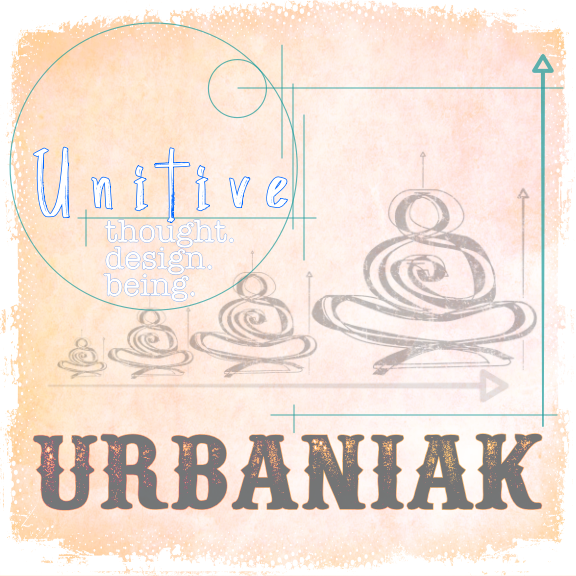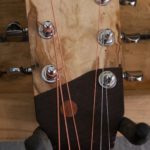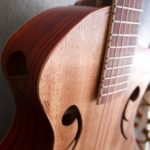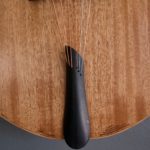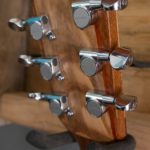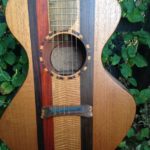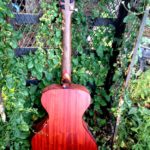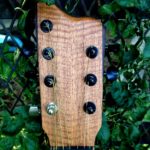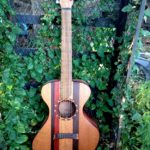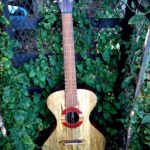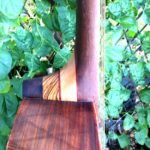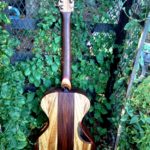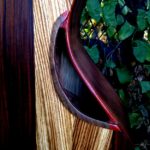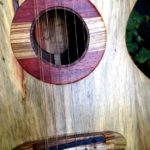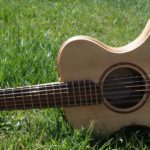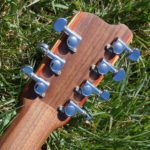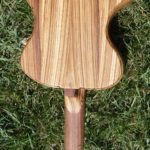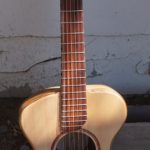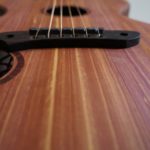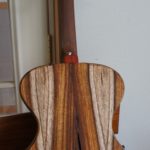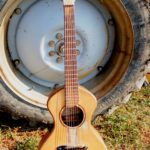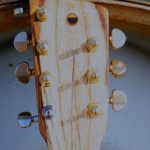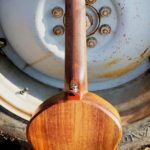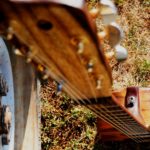Ghoti.

Ghoti-ca-002 (The Ghoti is a slightly remodeled Lighthouse style guitar – small body with the 14″ lower bout)
African Mahogany top and back, Padouk sides, ebony tailpiece recycled from old an old cello that was a student instrument in the 70’s, Black Walnut neck, Rosewood fretboard, Tacoma (Gotoh) machine heads, Ash headstock that is bound by Leopard wood with Maple and Wenge veneer.
2013 Lighthouse – Letter writer guitar.
Padouk back and sides, Spanish Cedar top with Padouk and Indian Rosewood stripes. Peruvian Walnut grafting, Black Walnut neck with a stacked heal block and a Spanish Cedar head stock veneer. Tacoma (Gotoh) machine heads and the seventh string.
Lighthouse.
Blue Pine top with an extruded Padouk and Zebrawood rosette. Pau Ferro(Morado) sides, Zebrawood and Pau Ferro back with a rear sound port, Peruvian Walnut neck, and stacked heal block.
This guitar speaks of artist expression and hangs snuggly onto it’s projections. That top, though, is far an away settled into my favorites category. I just lud (love – one of those kid words a parent holds onto) it so much.
Lighthouse – 002 – early 2013
Repurposed Spruce top, Zebrawood back and sides, Black Walnut neck. These were the smallest guitars that I built that were similar to a parlor guitar but meant as an ergonomic approach to the coupling of shape and function. Whether they are that or not never gets mentioned again. Ever.
Every instrument I build is in almost all ways, hand built. Over the years I’ve become considerably better at consistency of form, but still each instrument can be felt and understood as having been hand formed.
Lighthouse – 001 – Earliest 2013
Koa wood back and sides. Fence post top – Juniper – with two sound holes (experimental). This was a prototype guitar that implemented the use of asymmetry to support experimental ideas of ergonomics. This guitar was used to record One-way Ticket, was filmed in the video, and then I gifted it. These are the only two pictures I have of this bugga because it was at a time when photos would become the after thought.
This guitar was my first big push out of the clutches of the current standard. I wanted a deeper connection to the instrument, but it would need a sort of ‘instrument’s soul’ to get there. I almost lost that connection within the building world along the way. I’m glad that it somehow hung on and claimed buoyancy within the sea of everything else.
Ghoti – 001 – The journey back to symmetry
Spruce top with a Koa wood center stripe; wormy Koa back and sides; Black Walnut neck; Koa headstock veneer; Grover machine heads.
This is my personal guitar. It has made the journey across our country many times, and will many more times. The small body and the setup make this such an amazing stage guitar. Acoustics and electronics do not go favor for favor on instruments as is a common thought among people. What this guitar lacks in bare acoustic presence, it more than doubles in its plugged in quality. It’s far and away the most ‘acoustic’ sounding plugged in guitar I have heard. Something about it just sings.
The lighthouse guitar shape had started to wear on my vision; I wanted to redefine my building principles, too, so a new approach was needed. A journey back to symmetry. I didn’t want to do away with ergonomics completely, but ergonomics alone cannot support the duties of a great instrument. The cup for the implementation of experimental building was becoming full – it was time to approach the next levels. Taking the load of experience and applying it more in the forward than in the sideways direction. So much road left to travel, but the distance covered has been great so far.
